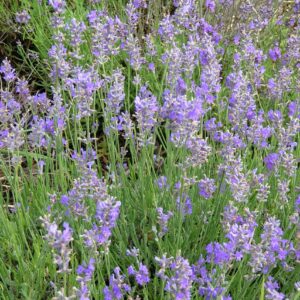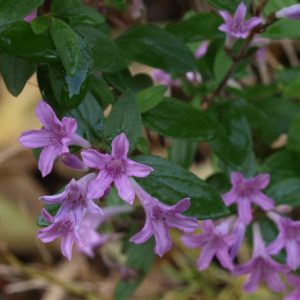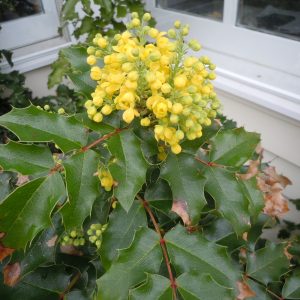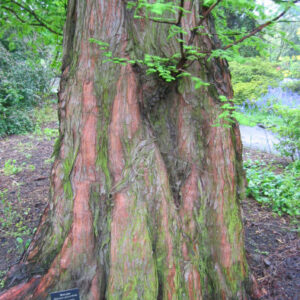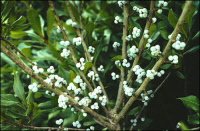Woody Ornamentals
Showing 33–40 of 48 results
-
Lavandula angustifolia ‘Munstead’ Z 5-9
Very fragrant, compact form of Lavender
June and rebloom in late summer, very fragrant lavender spikes
Size: 12-18” x 12-18”
Care: Sun, well drained moderately fertile soil
Native: Selection of Western Mediterranean nativeThis selection introduced to gardens in 1916. Name is Latin from “lavare” meaning to wash because Romans used lavender to scent their baths. Ancient Phoenicians used lavender to make perfume. Cultivated in Islamic gardens by 1050 A.D. Queen Elizabeth, I ate lavender conserve, made by adding sugar to the flowers while Charles VI of France stuffed pillows with lavender and sat on them. Culpepper, a 16th century English herbalist, wrote that lavender grew in almost every garden and cured headache, apoplexy, dropsy, fainting, toothaches, and “passions of the heart.” Jefferson grew it with herbs at his farm, 1794.
-
Leptodermis oblonga Dwarf lilac Z 5-8
fragrant lavender, lilac-like trumpets blooming in June – October.
Low mounding shrub with fragrant lavender, lilac-like trumpets blooming in June – October. Leaves slow to leaf-out in spring but then blooms its heart out.
Size: 12-18” x 18-24” spreads by suckers
Care: sun to part shade in moist well-drained to well-drained soil
Native: No. & W. China & Himalayas.
Wildlife Value: Attracts hummingbirdsLeptodermis means “thin skin” and oblonga refers to the oblong leaves.
Introduced by E.H. Wilson in 1905. -
Liriodendron tulipfera Tulip tree Z 4-9
Large tulip-shaped yellow-green petals surround orange corolla, Ornamental leaves turn yellow in fall
Large tulip-shaped yellow-green petals surround orange corolla, Ornamental leaves turn yellow in fall
Size: 80-100’ x 30’
Care: sun in well drained to moist well drained soil. Fast growing and strong wood.
Native: New England to FL, Ontario to IL, south to Louisiana and all states in between.
Wildlife Value: attracts Tiger swallowtail butterfly.
Awards: Recipient Great Plant Pick Award from Elizabeth Carey Miller Botanical Garden & England’s Royal Horticultural Society Award of Merit & Great Plants for Great PlainsOne of the oldest flowering trees – about 95 million years old. Cherokee cured pinworms, cholera, dysentery, coughs, wounds, boils, fever, bone fractures, indigestion, snakebites, and “women with hysterics” with Tulip tree. Because it is light weight but strong, they made canoes for up to 20 people with Tulip tree wood. The Rappahannock chewed the bark as a stimulant for sex. Sent to Europe by Tradescant the Younger (1608-1662) before 1640. Grown by Jefferson. Washington planted them as an allée around the serpentine bowling green at Mount Vernon.
**LISTED AS OUT OF STOCK BECAUSE WE DO NOT SHIP THIS ITEM. IT IS AVAILABLE FOR PURCHASE AT OUR RETAIL LOCATION.
-
Mahonia aquifolium Oregon grape Z 5-9
Clusters of buttercup yellow flowers in spring followed by glaucous blue fruit with red stems. Holly-like, evergreen leaves turn purple in fall for a four-season ornament.
Clusters of buttercup yellow flowers in spring followed by glaucous blue fruit with red stems. Holly-like, evergreen leaves turn purple in fall for a four-season ornament.
Size: 5’ x 3’
Care: sheltered site (in Z 5) in humusy, moist to moist well-drained soil, sun to part shade
Native: Pacific Northwest
Wildlife Value: Attracts bees & butterflies, Birds eat the berriesSnohomish ate the berries and made a yellow dye from its roots. It cured bloodshot eyes and kidney disease for Okanagan-Colville. California’s Karok Indians boiled the root and drank the liquid to cure numerous ailments. Steamed roots and leaves believed to remedy yellow fever. Lakota Sioux treated stomach, digestive, kidney and breathing ailments with this. Mahonia is named in honor of Bernard McMahon, (1775-1816) Scottish nurseryman who immigrated to Philadelphia around 1802. McMahon’s nursery received some seeds of plants and plants discovered by Lewis & Clark who collected this plant in April 1806 along the rapids of the Columbia River.
-
Metasequoia glyptostroboides Dawn redwood Z 4-8
Fast-growing, pyramidal-shaped deciduous conifer.
Fast-growing, pyramidal-shaped deciduous conifer. The orange to brown trunk base tapers and thickens with up to a dozen large buttress-like root flares extending several feet up the trunk. Feathery, fern-like, soft foliage emerges light green in spring, and turns red-bronze in fall before dropping. Its branches are well-attached and make excellent climbing.
Size: 70-90’ x 15-25’
Care: sun in moist to moist well-drained, slightly acid soil
Native: Szechuan China
Awards: Royal Botanic Garden Award of Garden Merit, Yew Dell Botanical Gardens’ Theodore Klein Plant Awards & Pennsylvania Horticultural Society GoldFrom fossil records, dawn redwood is known to have existed as many as 50,000,000 years ago. However, it was not until 1941 that dawn redwood was first discovered growing in the wild near the town of Modaoqi China by Chinese forester, T. Kan. Seeds collected from the original site were made available to the Missouri Botanical Garden in 1947. Seedlings grown therefrom were planted in front of the Lehmann Building at MBG in 1952 where they have now developed into large mature trees (70’+ tall). Dawn redwood is a deciduous, coniferous tree that grows in a conical shape to 100’ tall. It is related to and closely resembles bald cypress (Taxodium) and redwood (Sequoia).
-
Myrica pensylvanica syn. Morella pensylvanica Wax myrtle, Northern bayberry SHRUB Z 3-6
"...the berries are the thing – pewter in color, with a texture like those Fourth of July sparklers of childhood memory, they have a delicious fragrance.” Allen Lacy.
“…the berries are the thing – pewter in color, with a texture like those Fourth of July sparklers of childhood memory, they have a delicious fragrance.” Allen Lacy.
Size: 9’ x 10’
Care: sun in any soil
Native: Canada to Southeastern U.S. No pruning needed but can be pruned at any time of year, if desired.
Wildlife Value: Berries relished by chickadees, red-bellied woodpeckers, swallows, Titmouse, catbirds, bluebirds, Northern flicker & yellow-rumped warblers. Bayberry thickets also provide nesting sites for songbirds, offering excellent protection from predators.
Size: Fragrant leaves used for potpourri, abundant berries used to make candles. Good road-side plant, salt tolerant.Probably 1st collected for gardens by John Bartram (1699-1776). Offered for sale in Bartram Garden’s 1783 Broadside, America’s 1st plant catalog. In 1800’s considered “very ornamental in the shrubbery.”
**LISTED AS OUT OF STOCK BECAUSE WE DO NOT SHIP THIS ITEM. IT IS AVAILABLE FOR PURCHASE AT OUR RETAIL LOCATION.
-
Philadelphus lewisii Lewis’ Mock Orange Z 4-9
A triple delight. From late spring to early summer clusters of 2” wide, four-petaled, snow-white flowers with a center boss of sunny stamens smother this vase-shaped shrub. The flowers perfume the air with a delicious, orange scent. Then in fall the foliage turns citrus-yellow. Idaho adopted this as the state flower.
A triple delight. From late spring to early summer clusters of 2” wide, four-petaled, snow-white flowers with a center boss of sunny stamens smother this vase-shaped shrub. The flowers perfume the air with a delicious, orange scent. Then in fall the foliage turns citrus-yellow. Idaho adopted this as the state flower.
LIMITED QUANTITES AVAILABLE, LIMIT OF 1 PER CUSTOMER PLEASE.
Size: 5-10’ x 5-7’
Care: sun to part-shade in moist to well-drained soil
Native: from British Columbia to California, east to Montana.
Wildlife Value: Nectar and pollen attract bumble bees, moths, butterflies and hoverflies. It hosts caterpillars and chrysalises. Many birds eat the seeds.Natives used its strong and hard wood to make arrows, bows, combs, pipes for smoking, snowshoes, clubs, armor to protect chests, fishing spears, harpoon shafts, sticks for digging, knitting needles and baskets. Meriwether Lewis collected this plant in two places, in early May 1806 in Nez Perce County Idaho and two months later in Missoula County, Montana.
-
Philadelphus microphyllus syn. Philadelphus occidentalis Littleleaf mockorange, Western Mock Orange Z. 4-9
Four swan-white, undulating-edged petals on each flower circle around canary-colored stamens in early summer. Its flowers give off a strong fragrance of oranges with a hint of pineapple blooming from its multi-branch ends of these variable shrubs with yellow foliage in fall.
Four swan-white, undulating-edged petals on each flower circle around canary-colored stamens in early summer. Its flowers give off a strong fragrance of oranges with a hint of pineapple blooming from its multi-branch ends of these variable shrubs with yellow foliage in fall.
Size: 3-8’x 3-5’ big variations in size
Care: Sun in well-drained soil, drought tolerant
Native: West and southwest: CA, AZ, CO, NM, TX & UTIsleta Pueblo Indians ate the berries. Sanders, The Flower Garden (1913): “Forms a dense bush, 3 ft. high …flowers in summer, a pretty kind. A native of Colorado.”
**LISTED AS OUT OF STOCK BECAUSE WE DO NOT SHIP THIS ITEM. IT IS AVAILABLE FOR PURCHASE AT OUR RETAIL LOCATION.

